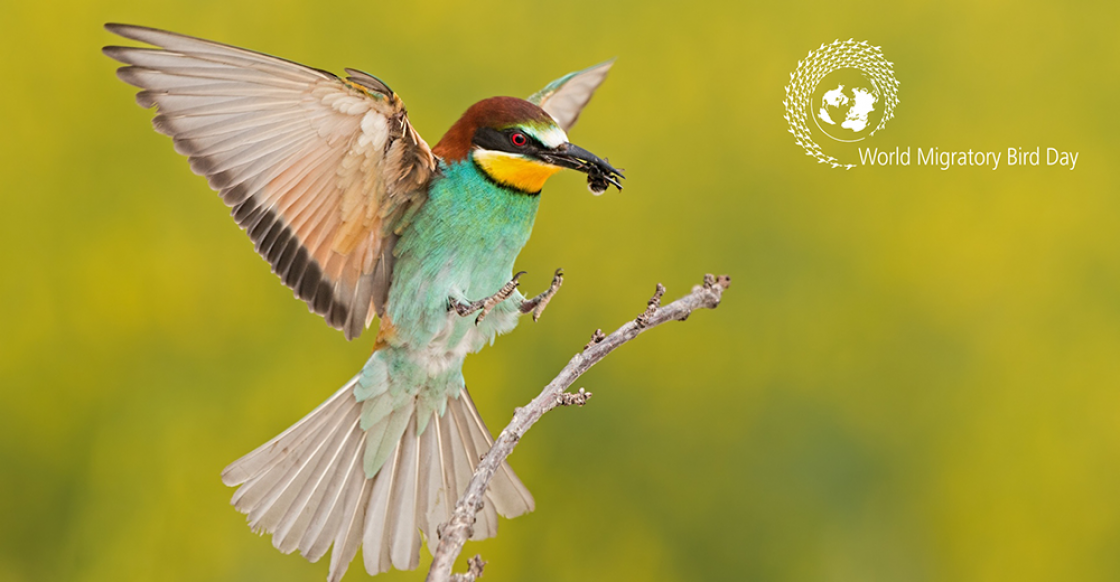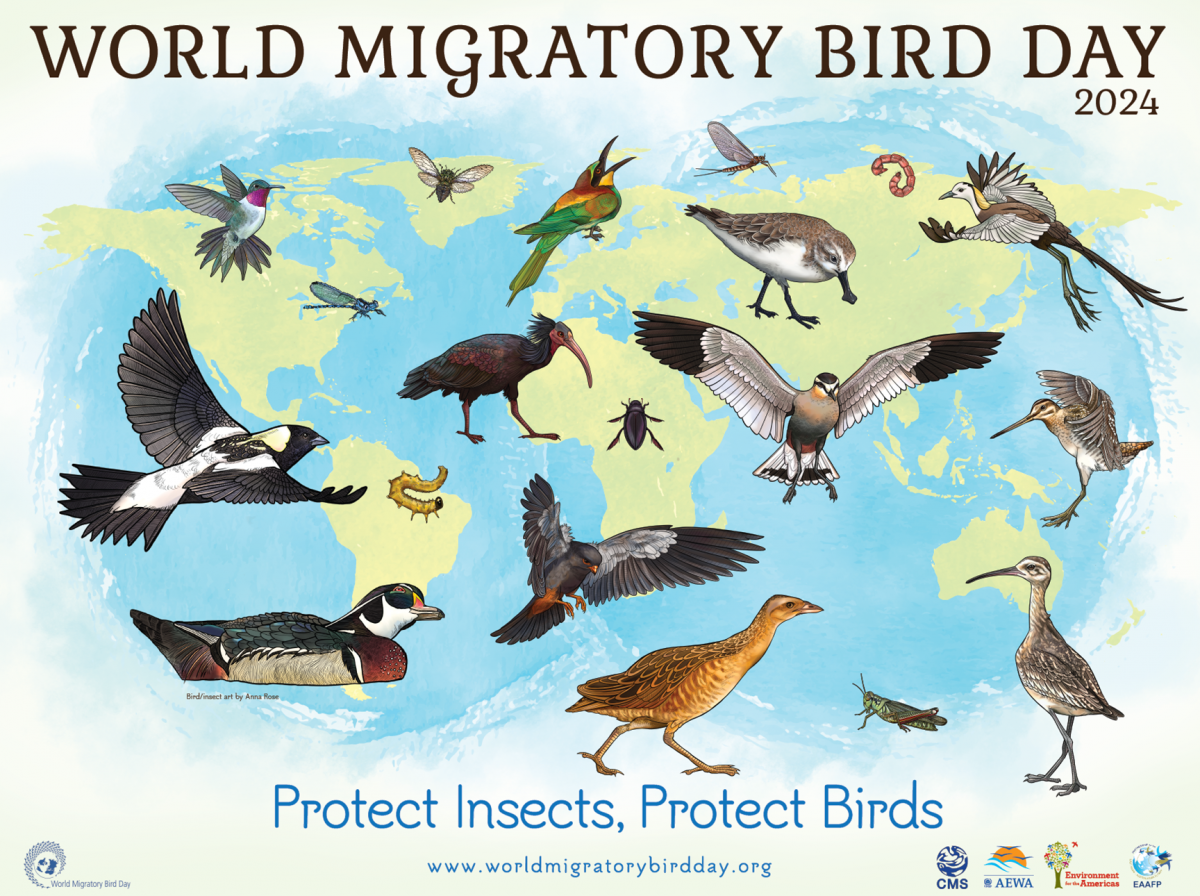You are here
PRESS RELEASE: World Migratory Bird Day 2024 Highlights Importance of Insects

World Migratory Bird Day 2024 Campaign Highlights the Decline of Insects Important to Many Species of Migratory Birds
BONN/BOULDER/INCHEON, 8 May 2024 – World Migratory Bird Day 2024 shines a spotlight on the relationship between migratory birds and insects amidst alarming declines for both.
World Migratory Bird Day is a global campaign that educates and promotes conservation efforts for migratory birds and their journeys across borders. It raises awareness about the challenges birds face and encourages conservation actions worldwide. World Migratory Bird Day triggers hundreds of educational events around the world that are united by their common goal of raising awareness and advocating for international bird protection. Each year the campaign features a central theme, prompts action, and coordinates global efforts to safeguard migratory birds and their habitats.
This year, the focus is on the importance of insects for migratory birds. Present in almost all the world’s ecosystems, insects are essential food sources for migratory birds on their long journeys. Migratory birds often time their migrations to align with insect abundance. They depend on these insects for food during migration stops and for breeding success and feeding their young.
The stark reality uncovered over recent years is that insect populations are declining, correlating with a decline in bird species reliant on insects for survival. An analysis in the journal Science revealed that we are losing roughly 9% of the world’s insect population each decade. Deforestation, industrial agriculture, the overuse of pesticides, light pollution, and climate change are major factors driving this trend (Reuters). Additionally, the United States and Canada have observed avian population declines, with a significant 29% drop in bird populations since 1970, equating to around 2.9 billion fewer birds.
This year's World Migratory Bird Day theme, "Protect Insects, Protect Birds" is an opportunity to raise awareness of the importance of insects, to educate, and to learn. It coincides with rare and fascinating insect events, such as the double-brood cicada emergence in North America and the synchronous fireflies event in the Smoky Mountains National Park, likely to be occurring in late May or early June. In other parts of the world, the migration of the “wandering glider” dragonfly (Pantala flavescens) stands out for its remarkable impact on the Amur Falcon's (Falco amurensis) journey across Asia and Africa. While in Europe, the decline of the Pied Flycatcher (Ficedula hypoleuca) has been linked to climate-related food shortages, whereby the birds now frequently arrive in European forests after the caterpillars have matured into insects, which their chicks cannot eat. The consequence of this mistiming was already published in Nature in 2006.
To mark the day, people around the world are invited to join in World Migratory Bird Day 2024 events and to take simple yet effective strategies to protect insects and birds.
World Migratory Bird Day 2024 Global Poster - Artwork by Anna Rose. / Available here in all UN languages
Some examples of actions being encouraged through the campaign include:
- Planting native gardens to create suitable habitats for wildlife
- Selecting organic products, thereby avoiding harmful pesticides
- Reducing habitat destruction linked to property development or landscaping practice
- Educating friends and family about the role insects play in our ecosystem
- Supporting educational efforts aimed at insect conservation, including promoting their conservation at the community level
- Creating laws and regulations to protect insects and migratory birds
- Encouraging local conservation activities to maintain natural habitats for insects, birds, and other wildlife
Events to celebrate World Migratory Bird Day, the phenomenon of bird migration, and the connections between birds and insects will take place across the world’s flyways on 11 May 2024.
For more information on World Migratory Bird Day, to find events, or to learn how to get involved, please visit www.worldmigratorybirdday.org.
About World Migratory Bird Day (WMBD):
World Migratory Bird Day is an annual awareness-raising campaign highlighting the need for the conservation of migratory birds and their habitats. It has a global reach and promotes action and gives inspiration to conserve both birds and their environments through education, public engagement, and joint activities across borders.
The campaign is organized by the Convention on the Conservation of Migratory Species of Wild Animals (CMS), the African-Eurasian Migratory Waterbird Agreement (AEWA), Environment for the Americas (EFTA), and the East Asian-Australasian Flyway Partnership (EAAFP).
Quotes:
“Insect populations are declining globally, and this is affecting many insect-eating migratory birds. While further research is needed to understand the extent of the problem, the decline of insects in many parts of the world is already having significant impacts on a range of migratory insectivorous species, especially bird and bat species. This has also recently been underlined by a CMS Report on Insects, presented at CMS COP14 in February 2024.”
- Amy Fraenkel, Executive Secretary of the Convention on Migratory Species (CMS)
“Insects are key to the survival and breeding success of many migratory birds. These include some migratory waterbirds such as the Northern Bald Ibis and the Sociable Lapwing – both AEWA endangered species that are also featured on the global World Migratory Bird Day poster this year. Intensive use of pesticides is one of the main reasons for the decline of insect populations. By protecting insects, we protect our migratory birds.”
- Jacques Trouvilliez, Executive Secretary of the African-Eurasian Waterbird Agreement (AEWA)
“We cannot live without our six-legged friends, the insects. Outnumbering us humans, they may be small, scary, and often irritating, stinging and biting, but as a crucial part of the food chain, they are what our world relies on. They are especially important to birds, as they are nutritious, full of protein, and many rely solely on them for food. So, to keep our bird species alive, avoid pesticides, value mosquitoes, grow plants that flower, and spread the message - insects for life,”
- Jennifer George, Chief Executive at the East Asian-Australasian Flyway Partnership (EAAFP)
“This World Migratory Bird Day, we highlight the relationship between migratory birds and insects, emphasizing the urgent need to protect them both. From the aerobatics of Cliff Swallows that capture insects in flight, to hummingbirds that feed them to their young, and the foraging of shorebirds that probe for insects in the sand and other habitats, it is evident that many birds rely on insects at various stages of their life cycles. Insects provide an essential source of energy for migratory birds, and the steep declines in grasshoppers, bees, butterflies, and other insects are a stark reminder that the conservation of birds depends on the successful protection of their insect prey. We invite you to join us in taking action to Protect Insects to Protect Birds.”
- Susan Bonfield, Executive Director of Environment for the Americas (EFTA)
Notes to Editors:
Images and interviews are available upon request.
Please inquire further to arrange for additional resources or expert commentary.
About the Convention on Migratory Species (CMS)
An environmental treaty of the United Nations, the Convention on the Conservation of Migratory Species of Wild Animals (CMS) provides a global platform for the conservation and sustainable use of migratory animals and their habitats. This unique treaty brings governments and wildlife experts together to address the conservation needs of terrestrial, aquatic, and avian migratory species and their habitats around the world. Since the Convention's entry into force in 1979, its membership has grown to include 133 Parties from Africa, Central and South America, Asia, Europe and Oceania.
Learn more at www.cms.int
About the Agreement on the Conservation of African-Eurasian Migratory Waterbirds (AEWA)
The Agreement on the Conservation of African-Eurasian Migratory Waterbirds (AEWA) is an inter-governmental treaty dedicated to the conservation of migratory waterbirds that migrate along the African-Eurasian Flyway. The Agreement covers 255 species of birds ecologically dependent on wetlands for at least part of their annual cycle. A total of 84 countries and the European Union have signed the environmental treaty, which has a geographic range covering 119 countries across Africa, Europe, the Middle East, Central Asia, Greenland, and the Canadian Archipelago.
Learn more at www.unep-aewa.org
About Environment for the Americas (EFTA)
Environment for the Americas connects people to nature and birds through research, education, and outreach. At the heart of our efforts lies the coordination of World Migratory Bird Day across the Americas, an initiative that engages people of all ages in the protection of our shared migratory birds. This work has also led to the development of our internship programs, which provide unique opportunities for the next generation of researchers, conservationists, and natural resource professionals. Through these programs, we are empowering young people to make a tangible difference for the environment. EFTA’s efforts have also spurred international collaborations for bird conservation and facilitated changes across borders that ensure a future where migratory birds are protected and celebrated.
Learn more at www.environmentamericas.org
About the East Asian-Australasian Flyway Partnership (EAAFP)
The East Asian–Australasian Flyway Partnership (EAAFP) is a flyway-wide framework to promote dialogue, cooperation, and collaboration among a range of stakeholders to conserve migratory waterbirds and their habitats. EAAFP was also recognized as one of the Ramsar Regional Initiatives in 2005 and was officially launched on 6 November 2006. With 40 partners, the partnership aims to protect migratory waterbirds, their habitats, and the livelihoods of people dependent upon them in the East Asian–Australasian Flyway.
For more information, visit www.eaaflyway.net
Citations:
Both, C., Bouwhuis, S., Lessells, C. et al. Climate change and population declines in a long-distance migratory bird. Nature 441, 81–83 (2006). https://doi.org/10.1038/nature04539
Douglas W Tallamy, W Gregory Shriver, Are declines in insects and insectivorous birds related?, Ornithological Applications, Volume 123, Issue 1, (2021). https://doi.org/10.1093/ornithapp/duaa059
Hallmann, C., Foppen, R., van Turnhout, C. et al. Declines in insectivorous birds are associated with high neonicotinoid concentrations. Nature 511, 341–343 (2014). https://doi.org/10.1038/nature13531
Janicki, J., Dickie, G., Scarr, S., & Chowdhury, J., The collapse of insects. Reuters (2022). Retrieved from The collapse of insects (reuters.com)
Rochlitz, J., Ott, D., & Sherber, C. Insect Decline and Its Threat to Migratory Insectivorous Animal Populations (2023). CMS COP14 Information Document: UNEP/CMS/COP14/Inf.30.4.2.
Roel van Klink et al. Meta-analysis reveals declines in terrestrial but increases in freshwater insect abundances. Science 368,417-420 (2020). DOI: 10.1126/science.aax9931
Related Links
World Migratory Bird Day Website: www.worldmigratorybirdday.org
Social Media Trello Board: www.worldmigratorybirdday.org/2024/resources
World Migratory Bird Day Global Event Map: www.worldmigratorybirdday.org/events-map
World Migratory Bird Day Event Finder: World Migratory Bird Day: Schedule
Social Media
Facebook: WorldMigratoryBirdDay
Instagram: @worldmigratorybirdday @environmentamericas
Twitter: @WMBD
Hashtags: #WorldMigratoryBirdDay #WMBD2024 #ProtectInsectsProtectBirds
For more information and expert interviews, please contact:
Florian Keil, Information Officer / Coordinator of the World Migratory Bird Day Campaign at the CMS and AEWA Secretariats, Tel: +49 (0) 228 8152451, [email protected]
Susan Bonfield, Executive Director at Environment for the Americas, Tel: +001 970-393-1183, [email protected]
Wen Qing Ng, Communications Officer at the East Asian-Australasian Partnership, Tel: +82 010 032 458 6504, [email protected]

